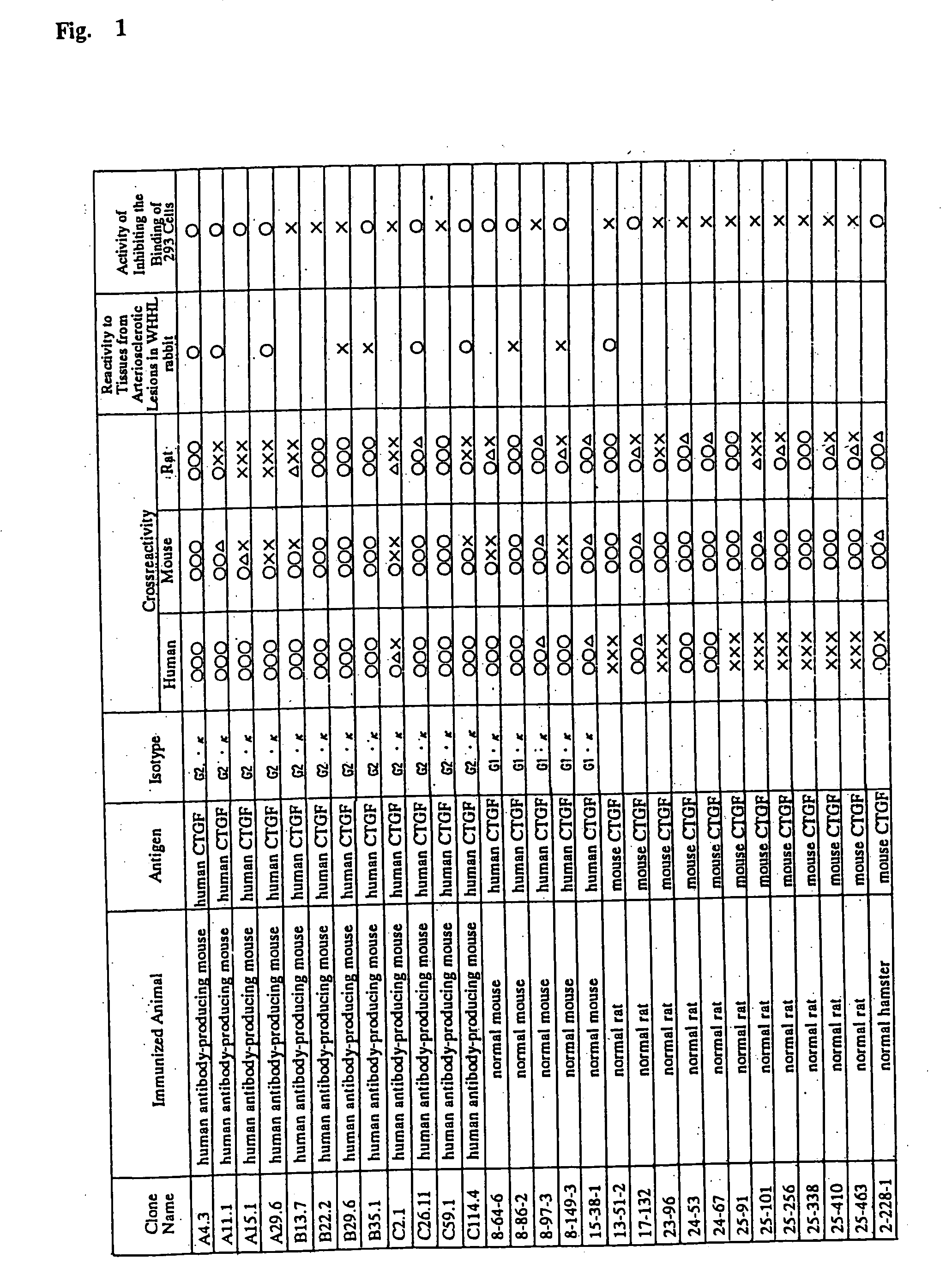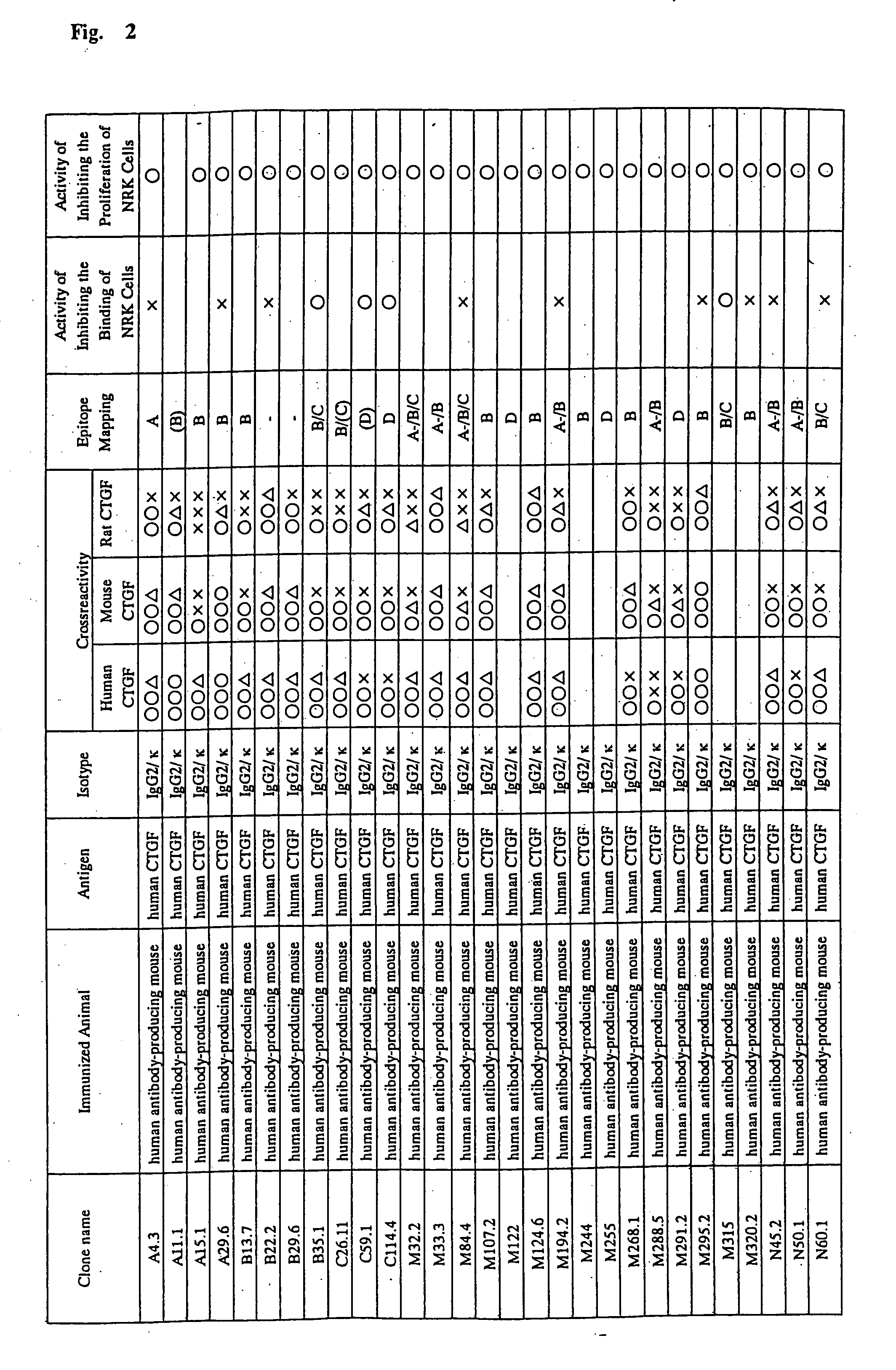Monoclonal antibody against connective tissue growth factor and medicinal uses thereof
- Summary
- Abstract
- Description
- Claims
- Application Information
AI Technical Summary
Benefits of technology
Problems solved by technology
Method used
Image
Examples
example 1
Preparation of a Polyclonal Antibody to Human CTGF
[0471] The peptide (Cys-Glu-Ala-Asp-Leu-Glu-Glu-Ash-Ile-Lys) corresponding to amino acid residues in the positions of 242 to 252 of human CTGF was synthesized with a peptide synthesizer (Applied Biosystems) according to a usual method. The peptide emulsified with Freund's complete adjuvant was used as an immunogen. The peptide (0.32 mg / kg) was given subcutaneously to a New Zealand white rabbit (NZW; Simunek, Inc.). The dose and the interval were: 0.8 mg of the peptide on day 1; 0.8 mg on day 14; 0.8 mg on day 35; and 0.8 mg on day 49. The antibody titer in the serum was assayed from time to time by using the peptide. The serum was then collected according to a usual method. The polyclonal antibody (IgG) against human CTGF was purified from the serum by affinity chromatography using agarose on which the peptide was immobilized. The reactivity to human CTGF was verified by Enzyme-linked immunosorbent assay (ELISA) and Western blotting...
example 2
Preparation of Recombinant Human CTGF
The Transient Expression of Human Recombinant CTGF in Human Kidney-Derived Fibroblast Cell Line 293
[0472] Complementary DNA encoding human CTGF was prepared according to a usual method by PCR. Specifically, the cDNA was prepared by using, as a template, heterogeneous cDNAs derived from a human chondroma cell line, HCS2 / 8, and by using primers designed based on the human CTGF cDNA sequence (The Journal of Cell Biology, Vol. 114, No. 6, p. 1287-1294, 1991). The human CTGF cDNA so obtained comprising the coding region was inserted into a plasmid, pcDNA3.1 (−) (Invitrogen Co.) to construct the expression vector. The human kidney-derived fibroblast cell line 293-T (ATCC CRT1573) was transformed with the prepared vector by electroporation. The transformant was cultured in a serum-free medium, ASF104 (Ajinomoto Co. Inc.), for three days, for the transient expression of the recombinant human CTGF. The human CTGF expression was confirmed by Western blot...
example 3
Preparation of Recombinant Mouse CTGF
[0476] Partially purified recombinant mouse CTGF was prepared by the same method described in Example 2, based on the cDNA sequence of mouse CTGF reported previously (Unexamined Published Japanese Patent Application (JP-A) No. Hei 5-255397; Cell Growth Differ., Vol. 2, No. 5, p. 225-233, 1991; FEBS Letters, Vol. 327, No. 2, p. 125-130., 1993; DNA Cell Biol., Vol. 10, No. 4, p. 293-300, 1.991).
PUM
| Property | Measurement | Unit |
|---|---|---|
| Composition | aaaaa | aaaaa |
Abstract
Description
Claims
Application Information
 Login to View More
Login to View More - R&D
- Intellectual Property
- Life Sciences
- Materials
- Tech Scout
- Unparalleled Data Quality
- Higher Quality Content
- 60% Fewer Hallucinations
Browse by: Latest US Patents, China's latest patents, Technical Efficacy Thesaurus, Application Domain, Technology Topic, Popular Technical Reports.
© 2025 PatSnap. All rights reserved.Legal|Privacy policy|Modern Slavery Act Transparency Statement|Sitemap|About US| Contact US: help@patsnap.com



